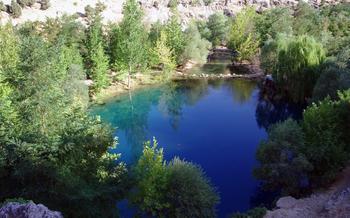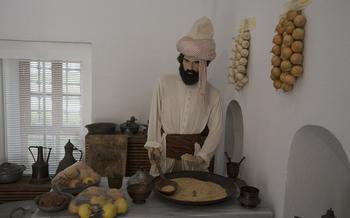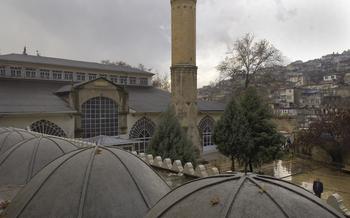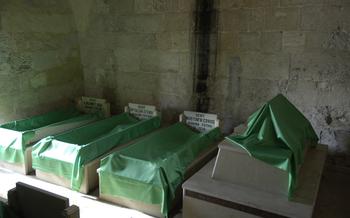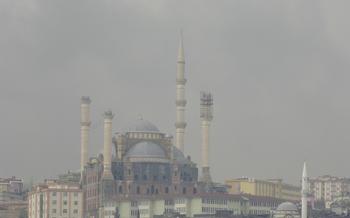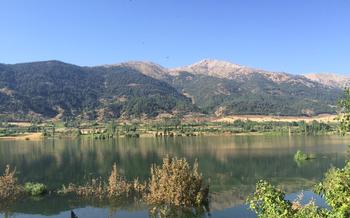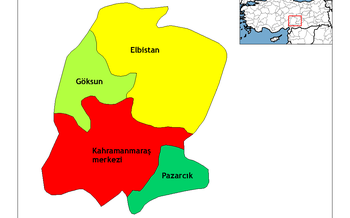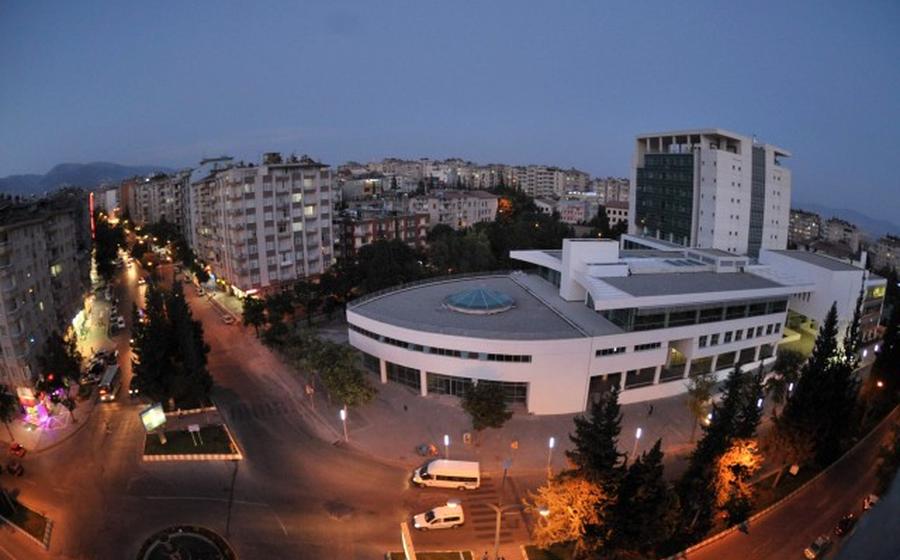
Kahramanmaras Historical City Bath
- History of the Kahramanmaras Historical City Bath
- Location of the Bathhouse
- Architectural Highlights
- Traditional Bathing Rituals
- Modern-Day Use of the Bathhouse
- Visiting the Bathhouse: Practical Information
- Exploring the Neighborhood
- Historical Significance of the Bathhouse
- Turkish Bath Culture
- Restoration and Preservation Efforts
- Cultural Events and Exhibitions
- Unique Features of the Bathhouse
- Nearby Attractions and Landmarks
- Insider Tip: Hidden Gems
History of the Kahramanmaras Historical City Bath
The, was constructed during the Ottoman era in the 16th century. This architectural marvel, commissioned by the renowned Ottoman governor İbrahim Pasha, served as a significant public bathing facility for the residents of Kahramanmaraş. Reflecting the architectural style prevalent during the Ottoman period, the bathhouse epitomizes the grandeur and artistry of Islamic architecture. Its historical significance lies in its enduring role as a central hub for social interaction, hygiene, and relaxation, offering a glimpse into the bathing traditions and customs of the Ottoman Empire.
Location of the Bathhouse
The Kahramanmaras Historical City Bath is situated in the heart of the city, at Sütçü İmam Square, Merkez/Kahramanmaraş. Nestled within the vibrant neighborhood of Eskişehir, it stands as a testament to the city's rich history and cultural heritage. The bathhouse is conveniently located near several prominent landmarks, including the Grand Mosque and the Kahramanmaras Museum. Its proximity to these attractions makes it an ideal starting point for exploring the city's historical and cultural treasures.
The bathhouse is easily accessible by public transportation, with multiple bus lines stopping nearby. The closest bus stop is located just a few steps away, ensuring that visitors can reach the bathhouse without any hassle. For those who prefer to drive, there are several parking options available in the vicinity.
Architectural Highlights
The Kahramanmaras Historical City Bath is a marvel of Ottoman architecture, showcasing unique features that set it apart from other bathhouses in Turkey. Its exterior façade boasts intricate carvings and decorative elements, hinting at the opulence that awaits inside. Step through the grand entrance and be greeted by a breathtaking central dome, supported by elegant columns and arches. The interior walls are adorned with colorful tiles and mosaics, depicting scenes from Turkish mythology and history. The stained glass windows cast a warm, ethereal glow, creating a mystical ambiance.
The bathhouse consists of several chambers, each serving a specific purpose. The sıcaklık (hot room) is the heart of the bath, where visitors can relax and sweat out impurities in the humid air. The soğukluk (cold room) provides a refreshing contrast, allowing bathers to cool down and cleanse their pores. The göbek taşı (navel stone), a large marble slab in the center of the sıcaklık, is where bathers receive traditional massages and exfoliation treatments.
Every corner of the Kahramanmaras Historical City Bath is adorned with intricate details, reflecting the artistry and craftsmanship of the Ottoman era. From the delicate tilework to the ornate carvings, the bathhouse is a testament to the rich cultural heritage of Kahramanmaraş.
Traditional Bathing Rituals
In the Kahramanmaras Historical City Bath, visitors can immerse themselves in the traditional bathing rituals that have been practiced in Turkey for centuries. The bathhouse is divided into separate sections for men and women, each with its own unique customs and etiquette. Upon entering, bathers are greeted by a tellak, or bath attendant, who guides them through the bathing process. The tellak assists with undressing, provides soap and towels, and performs a traditional kese scrub, which removes dead skin and impurities. After the scrub, bathers rinse off with warm water and relax in the steamy atmosphere of the bath. The tellak may also offer a massage, which is believed to promote relaxation and well-being. The entire bathing experience is designed to cleanse and rejuvenate both the body and the mind, creating a sense of tranquility and serenity.
Modern-Day Use of the Bathhouse
The Kahramanmaraş Historical City Bath has undergone a remarkable transformation in recent years, evolving from a traditional bathing establishment to a vibrant cultural hub. Recognizing its immense historical significance, the bathhouse was meticulously restored and converted into a museum, preserving its architectural integrity while adapting it to modern-day use. This transformation has breathed new life into the bathhouse, allowing it to continue serving as a cherished landmark while also contributing to the cultural fabric of Kahramanmaraş.
Preservation efforts have been paramount in ensuring the bathhouse's authenticity. Skilled artisans employed traditional techniques and materials to restore intricate tilework, decorative elements, and structural features, bringing the bathhouse's original splendor back to life. This painstaking work has not only preserved a valuable piece of history but also created a visually stunning and immersive experience for visitors.
The bathhouse now serves as a versatile space for cultural events and exhibitions, hosting a diverse range of activities that celebrate Turkish heritage and promote cross-cultural dialogue. Art exhibitions showcasing local and international artists, concerts featuring traditional and contemporary music, and educational workshops exploring Turkish bathing traditions are just a few examples of the events that grace the bathhouse's halls. These events not only attract tourists but also foster a sense of community among locals, strengthening the bond between the past and the present.
The transformation of the Kahramanmaraş Historical City Bath into a museum has not only preserved a historical treasure but also revitalized its role as a gathering place, where people can come together to experience and appreciate Turkish culture in all its richness and diversity.
Visiting the Bathhouse: Practical Information
- Entrance Fees and Operating Hours:
The Kahramanmaraş Historical City Bath is open to the public as a museum. Visitors are required to pay a modest entrance fee to enter the premises. The operating hours are typically from 9:00 AM to 5:00 PM, seven days a week. It's advisable to check the official website or contact the local tourism office for any updates or changes in the schedule.
- Guided Tours and Self-Guided Exploration:
Guided tours are available for visitors who want a deeper insight into the history and significance of the bathhouse. These tours are conducted by knowledgeable guides who provide detailed explanations and answer questions. Alternatively, visitors can opt for self-guided exploration, allowing them to wander through the bathhouse at their own pace and admire its architectural beauty.
- Photography and Videography Guidelines:
Photography and videography are generally permitted within the bathhouse, allowing visitors to capture the stunning visuals of the interior and exterior. However, it's important to be respectful of other visitors and avoid using flash photography, as it may disrupt the serene atmosphere of the bathhouse.
- Dress Code and Appropriate Attire:
Visitors are expected to dress appropriately when visiting the bathhouse. While there is no strict dress code, modest clothing that covers the shoulders and knees is generally recommended. This is out of respect for the historical and cultural significance of the bathhouse and its role as a place of relaxation and tranquility.
Exploring the Neighborhood
The Kahramanmaras Historical City Bath is situated in the heart of the city's historic center, surrounded by a vibrant neighborhood steeped in history and culture. Just a short stroll away, visitors can find themselves immersed in a labyrinth of narrow streets lined with traditional Turkish houses, shops, and cafes. The neighborhood is also home to several notable landmarks, including the Grand Mosque of Kahramanmaras, a magnificent architectural masterpiece dating back to the 16th century.
For those seeking a culinary adventure, the area surrounding the bathhouse offers an array of traditional Turkish restaurants and cafes serving mouthwatering local delicacies. Indulge in the flavors of freshly baked gözleme (stuffed flatbread) or savor the rich aroma of Turkish coffee while soaking in the vibrant atmosphere of the neighborhood.
For those with a penchant for shopping, the neighborhood presents a treasure trove of opportunities. Local shops and bazaars offer a diverse selection of handcrafted items, including intricate carpets, unique pottery, and exquisite jewelry. Visitors can haggle for the best prices and take home authentic souvenirs that reflect the cultural heritage of Kahramanmaras.
Exploring the neighborhood surrounding the Kahramanmaras Historical City Bath provides a glimpse into the rich history, vibrant culture, and culinary delights of this captivating city. Whether seeking spiritual enlightenment, culinary indulgence, or unique shopping experiences, visitors will find an abundance of attractions and activities to satisfy their wanderlust.
Historical Significance of the Bathhouse
The Kahramanmaras Historical City Bath holds immense historical significance, embodying the rich cultural heritage of the city. Constructed during the Ottoman Empire, it served as a vital social and cultural hub for the community. The bathhouse played a pivotal role in promoting cleanliness, hygiene, and relaxation among the people of Kahramanmaraş. Its architectural grandeur and intricate designs showcase the artistry and craftsmanship of the Ottoman era. As a testament to its historical significance, the bathhouse has been designated as a national monument, ensuring its preservation and protection for future generations. The Kahramanmaras Historical City Bath stands as a symbol of Turkish bathing traditions and Ottoman architectural heritage, offering visitors a glimpse into the past and a deeper understanding of Turkish culture.
Turkish Bath Culture
Bathhouses, known as "hammams" in Turkish, hold a significant place in Turkish society, transcending their practical function of cleansing. They are deeply embedded in the country's history, culture, and social fabric.
Turkish baths originated in the Ottoman Empire, where they served as communal spaces for bathing, relaxation, and socialization. They were often located in the heart of neighborhoods, becoming integral to the daily lives of people from all walks of life.
The bathing ritual in a traditional Turkish bath involves a series of steps designed to promote cleanliness, relaxation, and overall well-being. It typically begins with a warm-up in a steamy room, followed by a thorough wash and exfoliation using a kese (a rough cloth) and soap.
Beyond their hygienic benefits, Turkish baths have long been associated with health and wellness. The hot steam and massage help improve blood circulation, soothe sore muscles, and detoxify the body. The communal aspect of the bathing experience further contributes to its therapeutic value, providing a space for relaxation, socializing, and connecting with others.
Restoration and Preservation Efforts
The Kahramanmaras Historical City Bathhouse has undergone extensive restoration and preservation efforts to maintain its historical integrity and architectural beauty. The restoration process involved meticulous attention to detail, utilizing traditional techniques and materials to ensure authenticity. Skilled artisans and craftsmen worked diligently to restore the intricate tilework, decorative elements, and structural components to their original splendor.
Preserving the bathhouse required addressing various challenges, including the effects of time, environmental factors, and previous modifications. Experts conducted thorough research and analysis to understand the original design and construction methods. Structural reinforcement and repairs were carried out to ensure the safety and stability of the building.
The restoration efforts also focused on preserving the cultural heritage and significance of the bathhouse. Historical artifacts and inscriptions were carefully documented and restored to provide insights into the past. Collaboration between historians, architects, and conservators ensured that the restoration process respected the authenticity and integrity of this valuable historical landmark.
By preserving and restoring the Kahramanmaras Historical City Bathhouse, the local community and government demonstrate their commitment to safeguarding their cultural heritage. This remarkable monument stands as a testament to the rich history, architectural traditions, and cultural significance of Kahramanmaras and continues to be a source of pride for its citizens and a fascinating destination for visitors.
Cultural Events and Exhibitions
The Kahramanmaras Historical City Bathhouse has been transformed into a vibrant cultural hub, hosting a variety of events and exhibitions throughout the year. These events not only showcase the rich history and heritage of the bathhouse but also provide a platform for local artists, performers, and artisans to showcase their talents and connect with the community.
From art exhibitions featuring the works of local and international artists to concerts and performances that fill the air with music and dance, the bathhouse offers a unique and immersive experience for visitors. Workshops and educational programs are also organized, allowing participants to learn about traditional Turkish bathing rituals, art forms, and cultural practices. These events not only promote cultural exchange and dialogue but also contribute to the preservation and appreciation of Turkey's rich cultural heritage.
Unique Features of the Bathhouse
The Kahramanmaras Historical City Bath distinguishes itself with several unique and captivating features. Its architectural elements are a blend of traditional Turkish and modern European styles, creating a harmonious and visually striking edifice. The bathhouse is adorned with intricate carvings, decorative tiles, and stained glass windows, each showcasing the artistry and craftsmanship of its creators.
Upon entering the bathhouse, visitors are greeted by an impressive central dome, which allows natural light to flood the interior, creating a warm and inviting ambiance. The walls are adorned with intricate tilework and mosaics depicting scenes from Turkish history and mythology, adding to the bathhouse's cultural significance. These decorative elements not only enhance the aesthetic appeal of the bathhouse but also provide a glimpse into the rich artistic traditions of the region.
In addition to its architectural beauty, the Kahramanmaras Historical City Bath houses a collection of historical artifacts and inscriptions that shed light on its past. These artifacts include marble tablets with inscriptions in Arabic and Ottoman Turkish, providing valuable insights into the bathhouse's construction and operation. Furthermore, the bathhouse features a unique system of underground channels and pipes that supplied water to the various bathing areas, demonstrating the ingenuity and engineering prowess of its builders.
Nearby Attractions and Landmarks
Within the vicinity of the Kahramanmaraş Historical City Bath, visitors can embark on a journey of cultural and historical exploration. The Great Mosque of Kahramanmaraş, with its impressive architecture and religious significance, stands as a testament to the city's rich Islamic heritage. Kahramanmaraş Castle, perched atop a hill overlooking the city, offers breathtaking panoramic views and a glimpse into the region's ancient past. The Kahramanmaraş Museum houses a diverse collection of artifacts and exhibits that showcase the city's history, culture, and traditions.
Nature enthusiasts can find solace in the Kahramanmaraş Botanic Garden, a haven of tranquility filled with colorful flowers, lush greenery, and serene walking paths. The Kahramanmaraş Zoo provides a unique opportunity to observe a variety of animal species from around the world. For those seeking adventure, the nearby Mount Kahramanmaraş offers challenging hiking trails and stunning vistas. Whether you're a history buff, nature lover, or adventure seeker, the surroundings of the Kahramanmaraş Historical City Bath offer something for everyone.
Insider Tip: Hidden Gems
Beyond the main attractions, Kahramanmaraş holds a treasure trove of hidden gems waiting to be discovered. Just a short walk from the Historical City Bath, nestled in a charming alleyway, lies a hidden courtyard called "Gizli Bahçe" (Secret Garden). This tranquil oasis offers a serene escape from the bustling city, with lush greenery, colorful flowers, and a trickling fountain. Enjoy a cup of Turkish coffee or tea at the cozy café within the garden, and soak in the peaceful ambiance.
For those seeking a culinary adventure, venture off the beaten path to find authentic Turkish flavors. In the heart of the old city, discover "Lezzet Durağı" (Flavor Stop), a family-run restaurant renowned for its traditional Turkish dishes. Indulge in mouthwatering kebabs, freshly baked pide bread, and tantalizing mezes, all prepared with local ingredients and love.
History buffs will appreciate the "Kahramanmaraş Müzesi" (Kahramanmaraş Museum), which houses a fascinating collection of artifacts and exhibits showcasing the city's rich past. From ancient pottery and jewelry to traditional textiles and costumes, the museum provides a glimpse into the cultural heritage of Kahramanmaraş.
